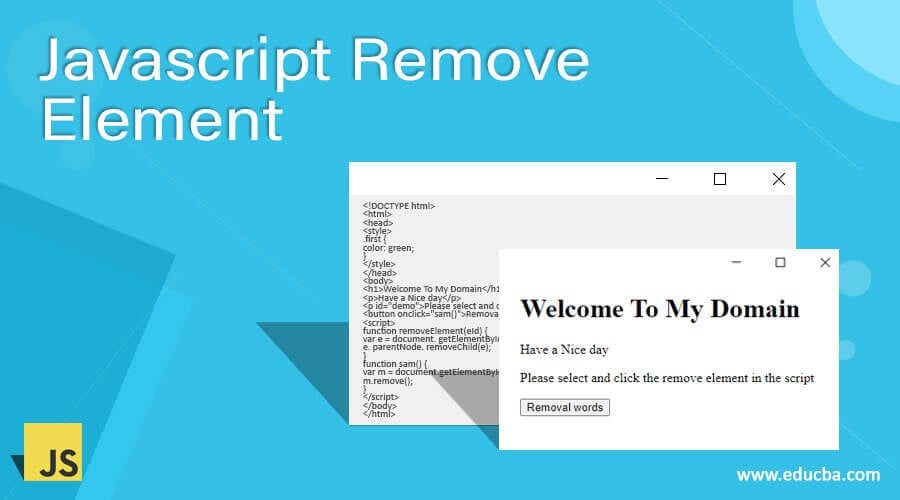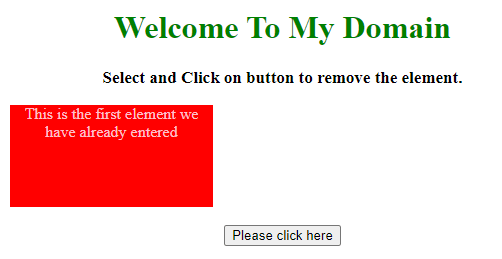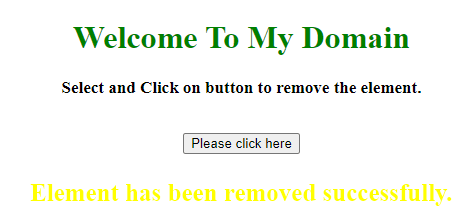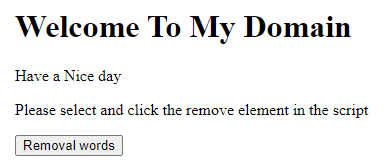Updated June 14, 2023

Introduction to Javascript Remove Element
In javascript, remove an element is one of the functions for removing the element in the script code using element id. With the help of the parent node, we can remove its child from the element. The Javascript element has different features, and its merits for accessing the script-based web application are user-friendly. DOM(document object model) will support removing the elements directly in the script code. The removing element will be in different ways of the script. We can remove the element by DOM, removing elements from arrays in the collections like map, list, etc., based on the requirement, we can remove it.
Syntax
The removing element is the feature for javascript to increase the memory and remove unwanted elements or data in the script.
<html>
<body>
<script>
function functionname()
{
var variablename=document.getElementById("");
variablename.parentNode.removeChild(variablename);
--some javascript logics---
}
</script>
</body>
</html>The above codes are the basic syntax for removing the elements in the script. Whatever we remove in the script specified in the javascript, the dom-based model needs the id for reference using the id; it can easily remove from the script.
How does Javascript Remove Element work?
The removing element is one of the features frequently used in the script. Whenever we want to add the elements in hand, it requires some space to store them in the memory that space has the reference was created. We will identify which parts were stored in the particular memory space area. Reference id is one of the important for fetching the elements in the memory. If we suppose we have a parent-child relationship like the inheritance concept, the parent node has one reference. The child nodes have another reference in javascript dom-based model fetch that uses the method called getElemetById(). Using these; we can pass the id as the parameter argument. After that, we can add or remove a new element based on the requirement. We will use the default method in the script.
We have already mentioned that in some cases, we use the removeChild() method to remove a specific child element in the script. Essentially, the DOM-based object model does not support the removal of elements. The remove() method has some different sets of types like removeAttribute(),removeAttributeNode(),removeChild(), and removeEventListener(), etc. The script will use these default methods to remove those specific elements with the features. If we want to remove the attribute for a particular element, we use a method like removeAttribute(). Using the removeAttributeNode() function, we will remove the attribute with the specified name of the object. Script code sometimes utilizes these types of methods as well.
While coming back to the removeChild(), method removes the specified child node of the specified element in the script. It will return the removed node as a Node object or null value if the node element does not exist in the script. The removed child node has no longer a time part of the DOM elements. The reference of the element returned by this method also it has possible to re-insert the specified removed child elements at a later amount of time which is one of the main advantages of this type of method. The removeEventListener() method will always be used to remove the event handler mechanism like the opposite of the addEventListener() form, and also parallelly, this method will remove it has the fraction of seconds in the period its also calculated whenever the specified element has to be removed the removeEventListener(), the method is not supported in the IE version like 8 and also the earlier type of versions. The removing element will mainly be used as the javascript library framework like jQuery. It’s used as the remove() method when a particular element has to be removed. If the particular child node is not for that parent node, it throws the Exception that the removeChild() method will return the child node removal from the DOM tree. Still, it keeps it in the memory location, which is also used later if required in the script.
Examples of Javascript Remove Element
Lets us discuss examples of Javascript Remove Element.
Example #1
Code:
<!DOCTYPE HTML>
<html>
<head>
<title>
First Remove Element in the script
</title>
<style>
#f {
background: red;
height: 102px;
width: 203px;
margin: 1 auto;
color: pink;
}
</style>
</head>
<body style = "text-align:center;">
<h1 style = "color:green;" >
Welcome To My Domain
</h1>
<p id = "u" style =
"font-size: 17px; font-weight: bold;">
</p>
<div id = "f">
This is the first element we have already entered
</div>
<br>
<button onClick = "sam()">
Please click here
</button>
<p id = "d" style =
"color: yellow; font-size: 25px; font-weight: bold;">
</p>
<script>
var a = document.getElementById('u');
var b = document.getElementById('d');
var c = document.getElementById('f');
a.innerHTML = "Select and Click on button to remove the element.";
function sam() {
c.parentNode.removeChild(c);
b.innerHTML = "Element has been removed successfully.";
}
</script>
</body>
</html>Output:
Example #2
Code:
<!DOCTYPE html>
<html>
<head>
<style>
.first {
color: green;
}
</style>
</head>
<body>
<h1>Welcome To My Domain</h1>
<p>Have a Nice day</p>
<p id="demo">Please select and click the remove element in the script</p>
<button onclick="sam()">Removal words</button>
<script>
function removeElement(eId) {
var e = document. getElementById(eId);
e. parentNode. removeChild(e);
}
function sam() {
var m = document.getElementById("demo");
m.remove();
}
</script>
</body>
</html>Output:
In the above example, we have clearly explained the remove() methods with different scenarios and types of removal methods like removeChild() methods.
Conclusion
From this point of view, JavaScript supports all the methods, like add(), remove(), append(), etc., in all types of browsers. However, older versions like Internet Explorer 8 do not support these default methods in certain instances. In such cases, users may encounter difficulties performing operations using these methods in their environment.
Recommended Articles
We hope that this EDUCBA information on “Javascript Remove Element” was beneficial to you. You can view EDUCBA’s recommended articles for more information.





